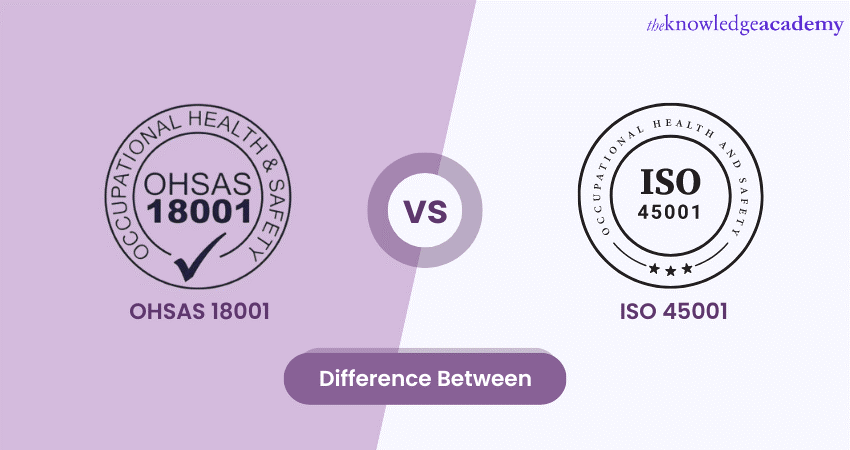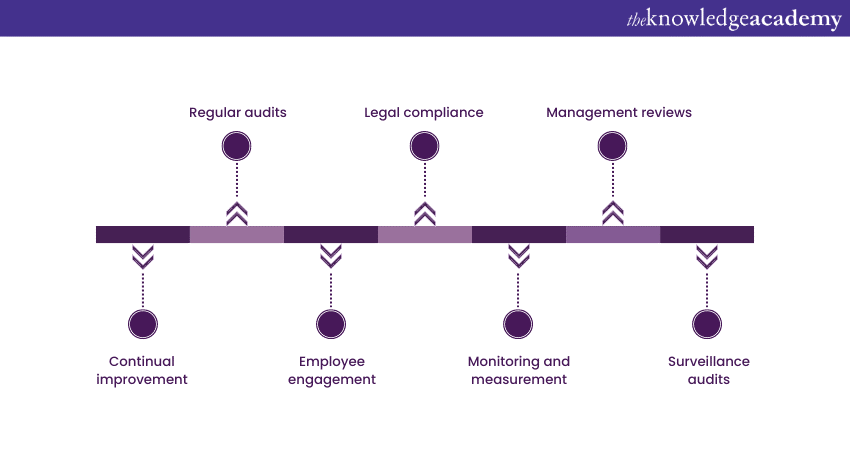We may not have the course you’re looking for. If you enquire or give us a call on 44 1344 203 999 and speak to our training experts, we may still be able to help with your training requirements.
Training Outcomes Within Your Budget!
We ensure quality, budget-alignment, and timely delivery by our expert instructors.

The Difference Between OHSAS 18001 and ISO 45001 Standards is a significant topic for organisations aiming to ensure the highest standards in Occupational Health and Safety. OHSAS 18001, previously a widely accepted standard, has been succeeded by ISO 45001 since September 2021, introducing enhanced guidelines and requirements.
Understanding the distinctions between these two standards is crucial for businesses seeking to align their practices with modern expectations and legal requirements. Read this blog to learn the key Difference Between OHSAS 18001 and ISO 45001 and their impact on an organisation's safety practices.
Table of Contents
1) A brief introduction to Health and Safety
2)An overview of OHSAS 18001
3) An overview of ISO 45001
4) What is the Difference Between OHSAS 18001 and ISO 45001?
5) How an organisation can maintain their ISO 45001 Certification?
6) Benefits of ISO 45001
7) Conclusion
A brief introduction to Health and Safety
Workplace Health and Safety is a comprehensive approach intended for the well-being and safety of employees within a work environment. It encompasses various aspects, from physical safety measures, like proper equipment handling and emergency protocols, to mental well-being, stress management and psychological support.
Additionally, employers are responsible for implementing and maintaining these measures, adhering to legal requirements and creating a culture where safety is a priority. The concept extends beyond the individual, as a safe and healthy workplace promotes efficiency, morale, and productivity.
Moreover, it is akin to the framework of a building, where each component supports the other to create a robust and nurturing environment. The concept is not merely a set of rules; it's an organisation's core, enhancing the overall quality of work life.
An overview of OHSAS 18001
OHSAS 18001, or the ‘Occupational Health and Safety Assessment Series’, is a British Standard for management systems in Occupational Health and Safety. The standard exists to help organisations implement demonstrably sound occupational health and safety practices.
The main aim of OHSAS 18001 is to guide organisations in managing and controlling their risks around health and safety while improving their overall performance. It defines the criteria for a balanced and structured approach to managing workplace health and safety, encouraging a culture where employees are aware of and actively participate in achieving safer working conditions.
Set your control guidelines and minimise risks at your workplace, by signing up for the ISO 18001 Foundation now!
An overview of ISO 45001
ISO 45001 is a standard recognised internationally for Occupational Health and Safety Management Systems, referred to by the acronym 'OHSMS', introduced in 2018. It replaced OHSAS 18001, setting more robust and flexible guidelines for organisations to ensure workplace safety.
Additionally, the core aim of ISO 45001 is to provide a framework that enables organisations to reduce accidents and illnesses by proactively improving occupational Health and Safety performance. It emphasises leadership, employee involvement, and a continuous improvement culture, helping organisations identify and control their health and safety risks.
Furthermore, compliance with ISO 45001 is not merely about meeting legal requirements; it demonstrates an organisation's commitment to protecting its employees' well-being. Applicable across all sizes and types of organisations, this standard integrates with other ISO management systems, offering a comprehensive approach to organisational management. By adopting ISO 45001, organisations make a strong statement about their dedication to workplace safety and health.
What is the Difference Between OHSAS 18001 and ISO 45001?
|
Aspect |
OHSAS 18001 |
ISO 45001 |
|
Publication Date |
2007 |
2018 |
|
Focus |
Primarily on managing and controlling risks |
Emphasises improving occupational health and safety performance |
|
Structure |
Aligned with the structure of other OHSAS standards |
Follows the common structure of other ISO standards |
|
Leadership requirement |
Limited requirements for top management |
Strong emphasis on leadership and commitment from top management |
|
Employee participation |
Employee participation is encouraged but not mandatory |
Strongly encourages employee participation and consultation |
|
Risk approach |
Focuses more on hazard control |
Concentrates on the proactive management of risks and opportunities |
|
Compliance obligations |
Concentrates on the proactive management of risks and opportunities |
More specific requirements for understanding and keeping up with legal obligations |
|
Documentation |
Focuses on prescriptive requirements for documentation |
Less prescriptive, offering flexibility in documentation |
|
Objectives and planning |
Emphasises setting, monitoring, and reviewing objectives |
Integrates objectives with other business processes for better alignment |
|
Integration |
Stands alone, more challenging to integrate with other management systems |
Stands alone, more challenging to integrate with other management systems |
|
Continual improvement |
Focuses on continual improvement but lacks specific guidance |
More detailed guidance on continual improvement processes |
|
Context of organisation |
Limited consideration of the context of the organisation |
Requires understanding the context, including external and internal factors |
|
supply chain management |
Minimal guidance on managing risks in the supply chain |
Enhanced guidance for assessing and managing risks in the supply chain |
|
Transition period |
No specific transition process as it has been replaced |
Organisations had a transition period from OHSAS 18001 to ISO 45001 |
How an organisation can maintain their ISO 45001 Certification?

Maintaining ISO 45001 certification within an organisation can be systematically approached through the following key actions:
a) Continual improvement: Regularly review and update Health and Safety Policies, procedures, and objectives to ensure alignment with the standard's requirements.
b) Regular audits: Conduct frequent internal and external audits to monitor compliance and identify improvement areas.
c) Employee engagement: Foster a safety culture by involving employees in safety-related decisions and training them on their roles and responsibilities.
d) Legal compliance: Continually assess and document adherence to legal and other regulatory requirements related to occupational health and safety.
e) Monitoring and measurement: Consistently monitor and measure OHS performance, making necessary adjustments.
f) Management reviews: Conduct periodic reviews to ensure the OHS management system aligns with the organisation's strategic goals.
g) Surveillance audits: Collaborate with a certification body to conduct surveillance audits, confirming that the system meets the ISO 45001 Standard.
Identify and assess workplace hazards, by signing up for the ISO 45001 Lead Auditor Course now!
Benefits of ISO 45001
Recognising the lives that are lost each day due to work-related illnesses and workplace accidents, the ISO 45001 Standard offers a framework for organisations to adopt, aiming to prevent such incidents and establish a secure and healthy work environment. Occupational health and safety have no alternative. Here are some of the benefits of implementing ISO 45001:
a) Build reputation as an industry leader
b) Develop a work environment that is trusted by both employees and visitors for its safety and health standards
c) Elevate employee morale creating a healthy work relationship at
d) Maintain current clients and attract new ones
e) Significantly reduce or completely eliminate workplace Hazards, risks, and accidents
f) Decrease downtime, redundancy, and sick leave, thereby increasing employee productivity
g) Guarantee customer satisfaction by meeting their requirement
Attain awareness about workplace safety, by signing up for the Health and Safety in the Workplace Training now!
Conclusion
The Difference Between OHSAS 18001 and ISO 45001 Standards lies in their approach, structure, and emphasis on leadership and employee engagement. ISO 45001 represents a more modern, comprehensive framework for Occupational Health and Safety management, building on the foundations laid by OHSAS 18001 and aligning with contemporary business practices. Understanding the distinctions between OHSAS 18001 vs ISO 45001 greatly benefits organisations in the long term while building and implementing their health and safety framework.
Understand the new ISO standard and its structure, by signing up for the ISO 45001 Foundation Course now!
Frequently Asked Questions

Organisations can align with both standards simultaneously, as ISO 45001 is designed to integrate seamlessly with other management systems. Transitioning entirely to ISO 45001 is not mandatory, but it offers a comprehensive framework for occupational health and safety.
Implementing a dual-compliance approach allows companies to meet specific industry requirements while benefitting from ISO 45001's internationally recognised best practices. This flexibility ensures organisations can enhance workplace safety without abandoning existing standards, promoting a holistic approach to health and safety management.

To seamlessly migrate from OHSAS 18001 to ISO 45001, businesses should follow these key steps:
a) Gap Analysis: Identify the differences between OHSAS 18001 and ISO 45001 requirements
b) Leadership engagement: Ensure top management commitment to the transition process
c) Employee involvement: Involve employees in understanding and implementing changes
d) Update documentation: Revise existing documents to align with ISO 45001 standards.
e) Training: Provide relevant training for employees on new requirements
f) Internal audits: Conduct internal audits to verify compliance
g) Certification body engagement: Collaborate with certification bodies for a smooth transition audit

The Knowledge Academy takes global learning to new heights, offering over 30,000 online courses across 490+ locations in 220 countries. This expansive reach ensures accessibility and convenience for learners worldwide.
Alongside our diverse Online Course Catalogue, encompassing 17 major categories, we go the extra mile by providing a plethora of free educational Online Resources like News updates, Blogs, videos, webinars, and interview questions. Tailoring learning experiences further, professionals can maximise value with customisable Course Bundles of TKA.

The Knowledge Academy’s Knowledge Pass, a prepaid voucher, adds another layer of flexibility, allowing course bookings over a 12-month period. Join us on a journey where education knows no bounds.

The Knowledge Academy offers various ISO 18001 Training, including ISO 18001 Foundation, ISO 18001 Lead Auditor etc. These courses cater to different skill levels, providing comprehensive insights into Mindfulness Techniques to Practice at Work.
Our Health and Safety blogs covers a range of topics related to ISO 18001 Foundation, offering valuable resources, best practices, and industry insights. Whether you are a beginner or looking to advance your Health and Safety management at workplace, The Knowledge Academy's diverse courses and informative blogs have you covered.
Upcoming Health & Safety Resources Batches & Dates
Date
 ISO 18001 Foundation
ISO 18001 Foundation
Mon 13th Jan 2025
Mon 17th Mar 2025
Mon 12th May 2025
Mon 14th Jul 2025
Mon 15th Sep 2025
Mon 10th Nov 2025







 Top Rated Course
Top Rated Course



 If you wish to make any changes to your course, please
If you wish to make any changes to your course, please


